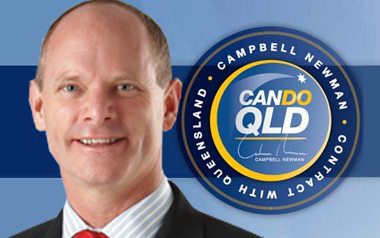It seems that the first achievement of newly-elected Premier Campbell Newman has been to redefine the boundaries of political risk for investors in the clean energy industry.
Newman’s promise to can a whole range of climate and clean energy program – in fact, the whole lot – is tempered only by the fact that he hasn’t yet looked at the details of the contracts. As he concedes. It will be interesting to see any change in content from what he shouts from the rooftop after advice from his media team and what he says after getting advice from lawyers.
He wouldn’t be the first newly-elected Tory Premier to make a goose of himself – Barry O’Farrell managed that when he announced retrospective cuts to the solar feed in tariff in NSW. He was forced to back-pedal quickly on that, but hasn’t forgotten the embarrassment. There will be no FiT in NSW as long as he is in power.
If Newman does succeed with ditching the $1.2 billion Solar Dawn project, or at least his contribution to it, the biggest loser will be the state’s credibility and the University of Queensland, which was to get $60 million in funding for ongoing research in solar thermal, specifically about investigating hybrid cooling and thermal energy storage technologies, mirror cleaning regimes and dispatch optimisation.
That is the point of the project – whatever you think of its economics, and it was always going to be fairly lousy for a “first time” technology, and on the scale that was contemplated – Solar Dawn was designed to provide valuable opportunities in learning and research, and even an opportunity for Australia to take a lead in such technologies. Newman can argue all he wants that having state-based schemes is “doubling up on a carbon tax”, but a carbon price does not deliver $60 million in funding to a university. Nor does it ensure that clean energy projects go to one state or another – that is one of the reasons why states have governments, to use their financial resources to attract investment.
Another research project at UQ, its geothermal energy centre of excellence, is also at risk because it relies on $15 million of funding from the renewable energy fund that Newman has also said will be canned.
The one success that Queensland can boast of is its feed-in-tariff for rooftop solar. In his policy document, Newman says the LNP “has already committed to retaining the solar feed-in tariff”, but it is not entirely clear if it will retain the current rate of 44c/kWh, and the solar industry is fearing the worst.
It is certainly under a lot of pressure to dump it, and AGL – one of the big three utilities – is leading the charge. In a quite extraordinary “blog”, AGL claims that other state-based tariffs have been wound back as a result of its own handiwork. “It would seem that policymakers have acknowledged the adverse consequences of feed-in tariff policies identified” by their own economists, it boasts.
Alas, there is a recalcitrant state. That sense of triumphalism has now inspired the company to attack the one remaining feed in tariff of any consequence in the country – the one that has actually been the most successful in creating a sustainable industry (400MW so far), and according to the AEMO, has come at minimal cost (0.013c/kW).
AGL itself admits the Queensland FiT has added less than one per cent to retail tariffs in the state. Undeterred, the AGL economists repeat their claims that it is a regressive tax, and while they acknowledge the merit order effect, the dampening effect of wholesale prices caused by renewable energy sources with low marginal costs, dismiss it as transfer of wealth from generators to consumers. Oh, no! What a disgraceful situation.
And this is the nub of the issue, as illustrated in this story on why generators hate solar. AGL is now the sole owner of the country’s most polluting power station, and one of the largest, Loy Yang in Victoria, and its investment in solar PV manufacturer Rezeko appears to be going less well than planned, and losing market share – so it is quite possible this is an issue for them too.
As the AGL document admits, its analysis is deliberately timed to try and bring a halt to the growth in the Queensland PV market – the healthiest in Australia, and which now accounts for more than one third of PV installations in the country. It holds up the situation in NSW as an example of what should be done. Because FiTs have been wound back elsewhere, AGL observes, “one might reasonably assume that the marketing efforts of installers will be more concentrated – with the ensuing market velocity presumably accelerating as a result.” Can’t have that now, can we? Not so much an economic analysis as a declaration of war.
Will Can-Do come to the rescue? You can be sure that AGL have shoved the document under his nose.






